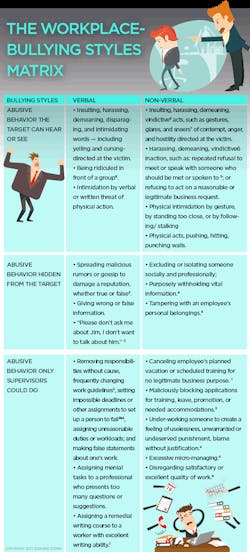The act of workplace bullying is not when a person simply acts rude toward another employee. Anyone, even the best of people, can have a bad day.
It appears in several dimensions. It can be verbal and non-verbal. Workplace bullying can be in-your-face and it also can be hidden from the victim/target. The hidden behavior often is overlooked.
The April 2013 (Federal) Interagency Security Committee’s report, "Violence in the Federal Workplace: A Guide for Prevention and Response," states “most acts of workplace violence occur as some form of verbal or non-verbal threat, bullying, harassment, or non-fatal physical assault.”
Your policy or next update to your old policy should cover these dimensions. A policy does not have to mention every possible way one person can bullying and torment another. Bullies will come up with new ways, but their conduct should be covered by this framework.
Overt Acts
Bullying can be obvious like screaming and cursing at someone in private or humiliating someone in public. Note that many anti-bullying policies state that a single act will not be considered bullying, unless it is egregious or severe. A single case of public humiliation still may have a long-lasting emotional and physical impact. Public humiliation should be considered severe behavior.
Bullying can be very subtle such as purposeful inaction. Examples of this would be repeated refusal to meet or speak to your coworker or your employee when that person has a reasonable expectation of meeting with you or speaking to you.
Physical intimidation such as gesture or expressions (e.g., cold glares, stares, and sneers) or by standing too close to someone also could be considered bullying. For instance, it may involve blocking someone's exit from her workspace. At that point, not only is that bullying, it may be criminal behavior. These are examples of non-verbal, overt abuse.
For reference, the U.S. Department of Labor workplace violence policy states: “Physical intimidation or harassment may include holding, impeding or blocking movement, following, stalking, touching, or any other inappropriate physical contact or advances.”
Hidden Bullying
Workplace bullying can be hidden from the intended target of the bully.
For instance, spreading rumors or gossip to damage people’s reputations behind their backs is recognized as bullying in every good program. It's verbal abuse, but it is not known to the victim. It is intended to hurt someone, and it does.
Does it matter whether the disparaging gossip is true or false? No. Gossip of private, true personal information is a malicious act, intended to hurt the victim. Next, purposely giving false information to a fellow worker to undermine his or her work also is bullying.
Purposely and maliciously excluding or isolating someone socially and professionally is non-verbal behavior. It may be hidden from the victim for some time. Purposely withholding vital information from a fellow worker is similar to social exclusion.
The Supervisory/Non-Supervisory Dimension
The foregoing examples of bullying could be performed by both supervisory and non-supervisory employees. Some conduct can only be done by a person with supervisory authority.
Supervisors have some organizational authority over their employees. Consequently, some harassment can be done by a supervisor that could not be done by non-supervisory personnel. For example: setting impossible deadlines , or otherwise setting up a person to fail, or assigning work or training out of malice, or denying leave or training out of malice, rather than for a legitimate business purposes, is abusive conduct. To be sure, some of these behaviors may not be immediately apparent. It may take some analysis to determine whether there is any misbehavior. (When the head of OSHA said we needed all staff working to finish up a regulation, I canceled vacation leave. That was for a legitimate business purposes, and the employee is still a friend of mine.)
When a supervisor assigns a remedial writing course to an employee, the assignment should be for legitimate business purposes. If they are both members of the Federal and State bar, and the female employee went to famous universities ranked much higher than her male boss’s schools, and her Verbal SAT was well into the 700’s, the assignment of a remedial writing class should raise a question. The assignment of the remedial course shortly after she testified about his verbal abuse of a co-worker should answer that question. That employer paid almost two million dollars to settle law suits by several women against that supervisor.
What is Not Bullying
Civil disagreement at work is not bullying. Factual, civil, professional criticism of work by a supervisor is not bullying; criticism and praise are part of the supervisor’s job. Also, stupid management decisions or failure to make decisions can be very annoying, but if they are not intended to degrade, demean, or undermine workers, they are not bullying. Lastly, if I am wrapped up in my thoughts and I don’t say “good morning”, that is not bullying. I will try to say “good morning” tomorrow.
1 Acts which at first glance look legitimate, upon investigation, may be seen as malicious.
2 Feigning reluctance to speak to imply that something is wrong with a person: “Equally reprehensible is the person who indulges in evil speech deceitfully, that is speaks as though innocently-unaware that what they say is an evil utterance.” –Maimonides, Hilchot Deot, 7:1-4
3Canada’s CCOHS: http://www.ccohs.ca/oshanswers/psychosocial/bullying.html
4 ADR.GOV www.adr.gov/events/2010/jan14-2010-materials-bullying.ppt
5 The NIH CIVIL Program Trifold Brochure, October 2014 https://hr.od.nih.gov/hrguidance/civil/documents/trifold.pdf
6 Edward J. Hines VA Hospital “Prevention of Workplace Harassment” (and Bullying), October 2012. “Bullying in the workplace is psychological violence”— often characterized by “insulting, hurtful, hostile, vindictive, cruel or malicious behaviors which undermine, disrupt or negatively impact another’s ability to do his or her job and results in a harmful work environment for the employee(s).”
7 “The Expression of Emotions in Man and Animals” by Charles Darwin 1872, Oxford U. Press 1996.

